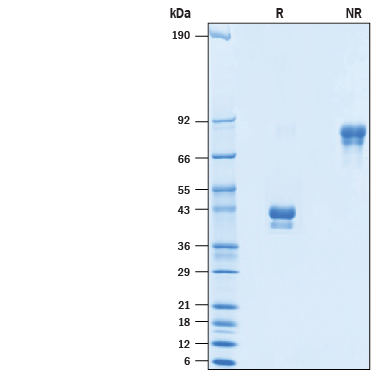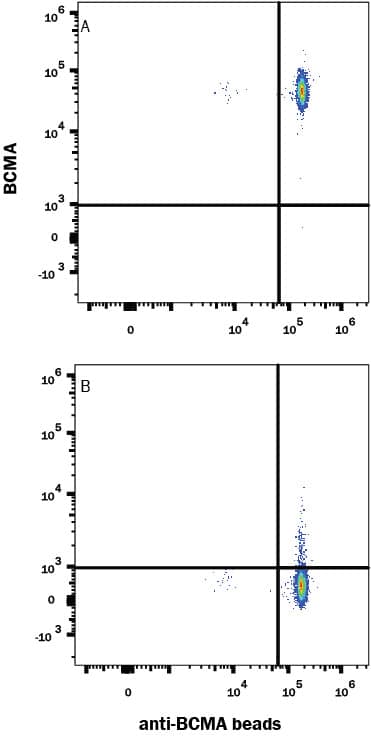Recombinant Human BCMA/TNFRSF17 Protein, Atto 488 Conjugate
R&D Systems, part of Bio-Techne | Catalog # ATJ193
Fc Chimera

Key Product Details
Learn more about FluorokinesTM Fluorescent-Labeled Proteins
Source
NS0
Accession #
Structure / Form
Disulfide-linked homodimer, labeled with Atto 488 via amines
Excitation Wavelength: 501 nm
Emission Wavelength: 523 nm
Excitation Wavelength: 501 nm
Emission Wavelength: 523 nm
Conjugate
ATTO 488 (Excitation= 501 nm, Emission= 523 nm)
Applications
Bioactivity
Product Specifications
Source
Mouse myeloma cell line, NS0-derived human BCMA/TNFRSF17 protein
| Human BCMA/TNFRSF17 (Met1-Ala54) Accession # Q6PE46 |
IEGRMD | Human IgG1 (Pro100-Lys330) |
| N-terminus | C-terminus |
Purity
>95%, by SDS-PAGE visualized with Silver Staining and quantitative densitometry by Coomassie® Blue Staining.
Endotoxin Level
<1.0 EU per 1 μg of the protein by the LAL method.
N-terminal Sequence Analysis
Met1
Predicted Molecular Mass
32 kDa (monomer)
SDS-PAGE
35-45 kDa, under reducing conditions
Activity
Measured by flow cytometry for its ability to bind
anti-Human BCMA Monoclonal Antibody conjugated fluorescent beads.
Scientific Data Images for Recombinant Human BCMA/TNFRSF17 Protein, Atto 488 Conjugate
Detection of Human BCMA Antibody with Recombinant Human BCMA/TNFRSF17 Fc Chimera Atto 488 Protein by Flow Cytometry
Fluorescent beads conjugated to anti-Human BCMA Monoclonal Antibody were stained with (A) Recombinant Human BCMA/TNFRSF17 Fc Chimera Atto 488 Protein (Catalog # ATJ193) or (B) unstained.Recombinant Human BCMA/TNFRSF17 Protein, Atto 488 Protein SDS-PAGE.
2 μg/lane of Recombinant Human BCMA/TNFRSF17 Fc Chimera Atto 488 (ATJ193) was resolved with SDS-PAGE under reducing (R) and non-reducing (NR) conditions and visualized by Coomassie® Blue staining, showing bands at 35-45 kDa and 70-90 kDa, respectively.Formulation, Preparation and Storage
ATJ193
| Formulation | Supplied as a 0.2 μm filtered solution in PBS with BSA as a carrier protein. |
| Shipping | The product is shipped with dry ice or equivalent. Upon receipt, store it immediately at the temperature recommended below. |
| Stability & Storage | Protect from light. Use a manual defrost freezer and avoid repeated freeze-thaw cycles.
|
Background: BCMA/TNFRSF17
References
- Hatzoglou, A. et al. (2000). J Immunol. 165:1322.
- Schiemann, B. et al. (2001). Science. 293:2111.
- Marsters, S.A. et al. (2000) Curr. Biol. 10:785.
- Huang, H. et al. (2013). PNAS. 110:10928.
- Laâbi, Y. et al. (1994). Nucleic Acids Res. 22:1147.
- Gras, M. et al. (1995) Int. Immunol. 7:1093.
- Coquery, C.M. et al. (2012) Crit Rev Immunol. 32:287.
- Laurent, S.A. et al. (2015) Nat Commun. 6:7333.
- Thaler, F.S. et al. (2017) Neuro Oncol. 19:1618.
- Seckinger, A. et al. (2017) Cancer Cell. 31:396.
- Lee, L. et al. (2018) Blood. 131:746.
Long Name
B Cell Maturation Factor
Alternate Names
CD269, TNFRSF13A, TNFRSF17
Gene Symbol
TNFRSF17
UniProt
Additional BCMA/TNFRSF17 Products
Product Documents for Recombinant Human BCMA/TNFRSF17 Protein, Atto 488 Conjugate
Product Specific Notices for Recombinant Human BCMA/TNFRSF17 Protein, Atto 488 Conjugate
For research use only
